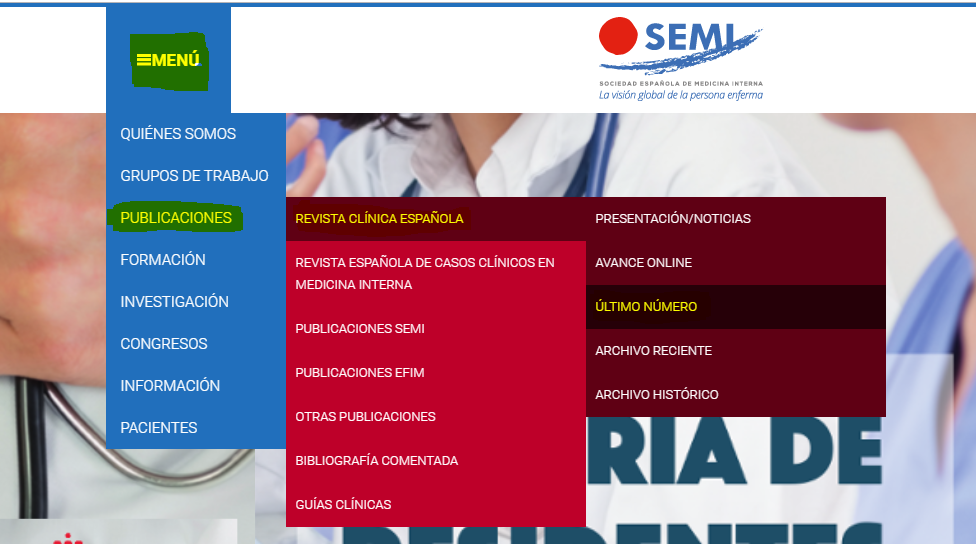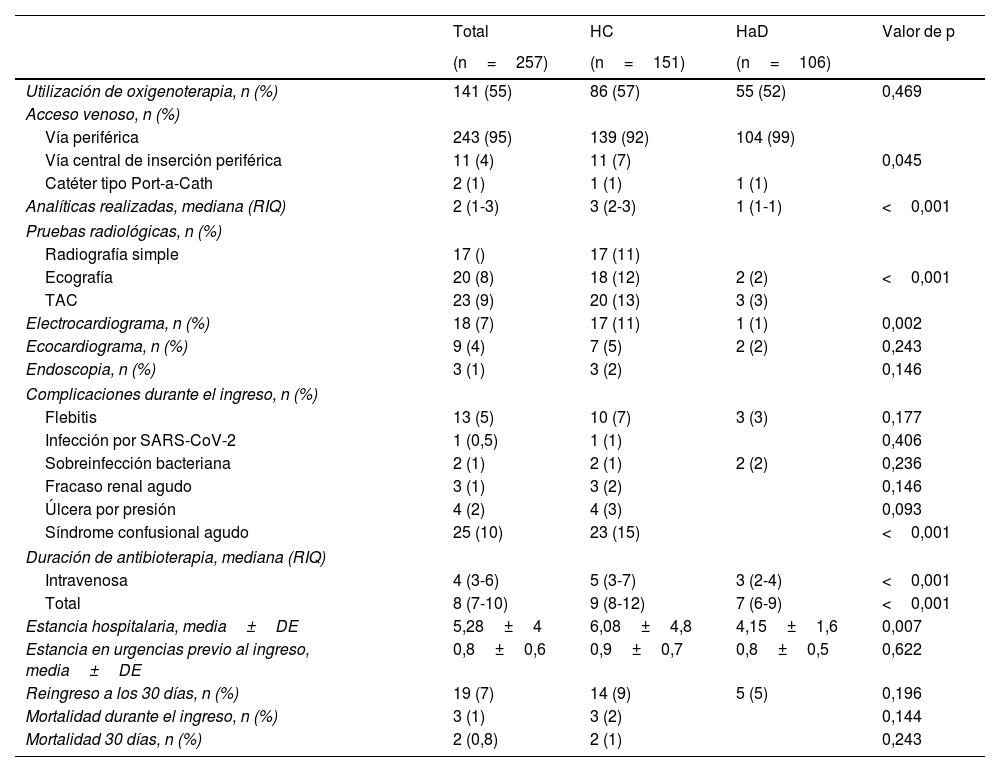La hospitalización a domicilio (HaD) es una modalidad asistencial segura, efectiva y más eficiente que la hospitalización convencional (HC). Existe poca evidencia científica que compare estos 2 modelos de hospitalización en los pacientes que ingresan desde el servicio de urgencias (SU) por infección.
Material y métodosEstudio retrospectivo de cohortes entre el 1 de octubre y el 15 de diciembre de 2023 de los pacientes que ingresan desde el SU por infección. Se analizaron 2 cohortes, la primera, los pacientes ingresados en HC en las unidades de medicina interna, geriatría o infecciosas y la segunda, los pacientes ingresados en HaD. Se excluyeron a los pacientes con inestabilidad hemodinámica, aquellos que fallecieron en las primeras 48h del ingreso, bacteriemia por S. aureus, bacteriemia asociada a catéter, infección osteoarticular, meningitis, diverticulitis, fiebre sin foco e infecciones con foco no drenado.
ResultadosSe analizaron 257 pacientes, 151 en HC y 106 en HaD. La mediana de duración de antibioterapia fue de 9 días en HC vs. 7 HaD (p<0,001), la estancia media fue superior en HC vs. HaD (6 vs. 4; p=0,007). Se realizaron más analíticas en HC vs. HaD (3 vs. 1; p<0,001), radiografías simples (11 vs. 0%), ecografías (12 vs. 2%) y tomografía axial computarizada (13 vs. 3%; p<0,001). Los pacientes ingresados en HC tuvieron más síndrome confusional que los ingresados en HaD (15 vs. 2%; p<0,001). No hubo diferencias en mortalidad ni reingresos. En el análisis de regresión lineal multivariante los pacientes ingresados en HaD acortan su estancia hospitalaria en un día (IC 95%: −2,2 −0,185) comparados con los ingresados en HC.
ConclusiónLos pacientes ingresados por infección en HaD procedentes del SU tienen una estancia hospitalaria menor que los pacientes ingresados en HC, sin aumento de la mortalidad ni de los reingresos.
Home hospitalization (HH) is a safe, effective and more efficient modality of care than conventional hospitalization (CH). There is little scientific evidence comparing these two models of hospitalization in patients admitted from the Emergency Department (ED) for infection.
Material and methodsRetrospective cohort study between October 1 and December 15, 2023 of patients admitted from the ED for infection. Two cohorts were analyzed, the first one, patients admitted to CH in Internal Medicine, Geriatrics or Infectious Diseases units and the second one, patients admitted to HH. Patients with hemodynamic instability, those who died in the first 48 hours of admission, S. aureus bacteremia, catheter-associated bacteremia, osteoarticular infection, meningitis, diverticulitis, fever without focus, and infections with undrained focus were excluded.
Results257 patients were analyzed, 151 in CH and 106 in HH. The median duration of antibiotherapy was 9 days in HC vs 7 in HH (p<0.001), the mean length of stay was longer in CH vs HH (6 vs 4; p=0.007). More laboratory tests were performed in CH vs HH (3 vs 1, p<0.001), radiographs (11% vs 0%), ultrasound (12% vs 2%) and computed axial tomography (13% vs 3%, p<0.001). Patients admitted to CH had more confusional syndrome than those admitted to HH (15% vs 2%; p<0.001). There were no differences in mortality or readmissions. In the multivariate linear regression analysis, patients admitted to HH shortened their hospital stay by 1 day (95% CI: -2.2– -0.185) compared to those admitted to CH.
ConclusionPatients admitted for infection in HH from the ED have a shorter hospital stay than patients admitted to CH.
Article
Diríjase desde aquí a la web de la >>>FESEMI<<< e inicie sesión mediante el formulario que se encuentra en la barra superior, pulsando sobre el candado.

Una vez autentificado, en la misma web de FESEMI, en el menú superior, elija la opción deseada.

>>>FESEMI<<<








